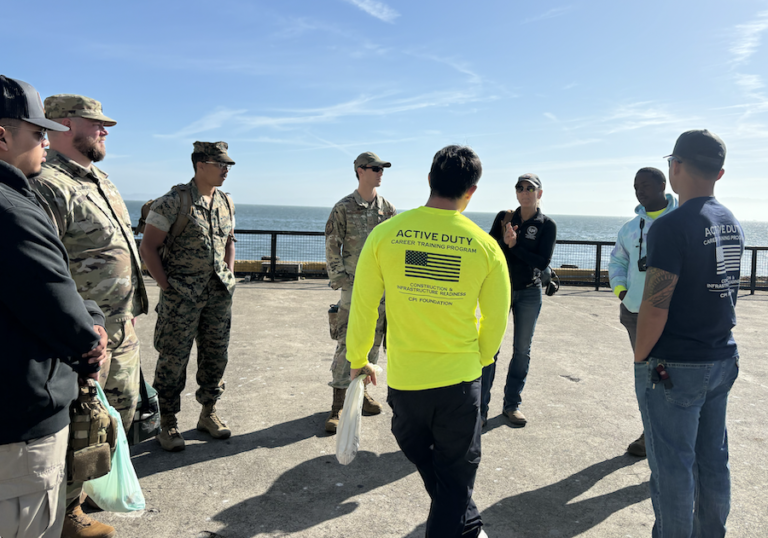On a sunny May morning, Alcatraz Island was, as usual, full of tourists exploring the concrete structures and learning about the colorful history of the former prison. But for seven of them, the tour wouldn’t end until August. They were active-duty U.S. military members who, over the next 12 weeks, would learn about and potentially pursue careers in construction.
Cody Hartman, a senior airman in the US Air Force, did just that. According to the Concrete Preservation Institute (CPI) Foundation, which spearheads the program, later this month he accepted an offer from Hensel Phelps as a field engineer.
“Three of our other summer session participants have had initial interviews with Turner Construction and anticipate scheduling follow-up calls in the near future,” says Michael Farris, vice president and director of relations for the CPI Foundation. “Another of our summer session participants has been accepted into an electrical union.”
According to CPI, 200 to 250,000 service members leave the military each year, many of whom seek careers in the civilian world; CPI works with active duty personnel at the beginning of their transition from service to civilian.
Hartman learned about CPI through the Defense Department’s SkillBridge program, he said during an interview on the program’s first day. “It really caught my eye — working on Alcatraz doing concrete preservation work,” he said. “It’s something very unique and a great opportunity to do something a little different from new construction. And a major emphasis of the program is networking capabilities. So they train you, and that aspect of the network is to get a career after that.”
The CPI Foundation is a non-profit organization that partners with the US Department of Defense and the US National Park Service, training active-duty military service members to help repair landmark structures in Alcatraz Island and the Pearl Harbor National Memorial, and connect them with construction companies nationwide.
Tanya Komas, CEO of the foundation, was a professor at Chico State University teaching construction industry management. He recalls that in 2010, when the industry was still recovering from the Great Recession, “nobody was hiring” construction interns. But a connection with the National Park Service allowed him to bring his students to Alcatraz Island, with its 13 acres of aging concrete structures.
“In 2013, we had this program on Alcatraz Island,” he says. “I decided to set it up full-time for veterans.” In 2015, the Department of Defense asked him to help fulfill a congressional charge: to do a better job with transitions from military to civilian careers.
In 2016, the program expanded to the Pearl Harbor memorial with the Department of Defense. The U.S. National Park System has $12 billion in needed repairs to its infrastructure, according to the CPI.

Alcatraz’s many old concrete structures provide a construction training ground for CPI Foundation students. Photo by Aileen Cho/ENR
Hensel Phelps became involved with the program after meeting the apprentices at Pearl Harbor in 2019, says Robert DeSpain, HP’s general superintendent for Southern California. “I found it to be an invigorating organization that has a lot to offer veterans coming into their final months of active duty,” he says, adding that the contractor has hired several.
Students in the program keep their military pay and GI Bill benefits while receiving free housing, transportation and equipment. “There aren’t many programs that are completely free,” said Isaac Williams, a Marine corporal, adding that “the team is very small, so it’s more focused.”
Jacob Rodríguez, who specializes in geospatial intelligence in the Army, said during the first day that he wants to get a job as an electrician. “They’re really setting me up for success by helping with team payments and going to interviews, even helping us with our resumes.”
Marine Corps Marine Zachary SanJose echoed that sentiment: “One thing that I think is really cool about this company is the networking capabilities, understanding that we don’t come from any prior experience, like now the actual building or the whole world. And so they open the door and guide us and also take us to places that we never knew were possible because of the networking capabilities is a very interesting thing.”
Corey Asato, a communications major for the Navy, noted that while the program emphasizes concrete, it exposes students to the broader construction opportunities. “In terms of the concrete and construction industry, there’s a more full-spectrum approach. So we’re looking at how we can translate our military skills into construction careers.
Jay Gawronski, an Army SgtSt class, added, “One of the things that definitely appealed to me about the program is that you don’t have to be the guy who actually does the manual work. There are foremen, there are superintendents, all kinds of positions, whether you want be in web design for a construction company as accounting or product sales…whatever you want to do, there is definitely a place for you.
The fall training program will have participants work on stabilizing the former Warden’s House and structurally repairing a utility vault that runs between the island penitentiary and the morgue, Farris says. “With these upcoming larger projects, we’ve been working with our park service partners to identify and arrange additional housing, and it looks like we’ll be able to accommodate many more participants than normal,” he says.
Charles Porter, a Marine infantry rifleman who threw grenades, appreciated the historic aspect of the preserve. “Personally, I think what you can do as a construction worker has a lot of benefits, especially repairing old historical sites. There’s a story behind it, and the job is to preserve it.”

